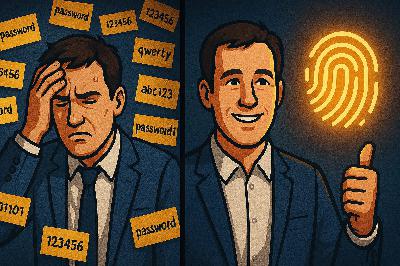Passwords Are Broken—Passkeys Fix Everything
Description
Passwords don’t fail because users are careless. They fail because the system itself is broken. Phishing, credential stuffing, and constant resets prove we’ve been leaning on a weak foundation for decades. The fix already exists, and most people don’t realize it’s ready to use right now. In this session, I’ll show you how passkeys and WebAuthn let devices you already own become your most secure login method. You’ll get a clear overview of how passkeys work, a practical ASP.NET Core checklist for implementation, and reasons business leaders should care. Before we start, decide in the next five seconds—are you the engineer who will set this up, or the leader who needs to drive adoption? Stick around, because both roles will find takeaways here. And to see why this matters so much, let’s look at the real cost of relying on passwords.
The Cost of Broken Passwords
So why do so many breaches still begin with nothing more than a weak or stolen password, even after organizations pour millions into security tools? Firewalls grow stronger, monitoring gets smarter, and threat feeds pile higher, yet attackers often don’t need advanced exploits. They walk through the easiest entry point—the password—and once inside, everything downstream is suddenly vulnerable. Most businesses focus resources on layered defenses: endpoint protection, email filtering, threat hunting platforms. All valuable, but none of it helps when an employee recycles a password or shares access in a hurry. A single reused credential can quietly undo investments that took months to implement. Human memory was never meant to carry dozens of complex, unique logins at scale. Expecting discipline from users in this environment isn’t realistic—it’s evidence of a foundation that no longer matches the size of the problem. Here’s a common real-world scenario. An overworked Microsoft 365 administrator falls for a well-crafted phishing login page. The attacker didn’t need to exploit a zero-day or bypass expensive controls—they just captured those credentials. Within hours, sensitive files leak from Teams channels, shared mailboxes are exposed, and IT staff are dragged into long recovery efforts. All of it triggered by one compromised password. That single point of failure shows how quickly trust in a platform can erode. When you zoom out to entire industries, the trend becomes even clearer. Many ransomware campaigns still begin with nothing more than stolen credentials. Attackers don’t require insider knowledge or nation-state resources. They just need a population of users conditioned to type in passwords whenever prompted. Once authenticated, lateral movement and privilege escalation aren’t particularly difficult. In many cases, a breached account is enough to open doors far beyond what that single user ever should have controlled. To compensate, organizations often lean on stricter policies: longer password requirements, special characters, mandatory rotations every few months. On paper, it looks like progress. But in reality, users follow patterns, flip through predictable variations, or write things down to keep track. This cycle doesn’t meaningfully shrink the attack surface—it just spreads fatigue and irritation across the workforce. And those policies generate another hidden cost: password resets. Every helpdesk knows the routine. Employees lock themselves out, reset flows stall, identities must be verified over the phone, accounts re-enabled. Each request pulls time from staff and halts productivity for the worker who just wanted to open an app. The cost of a single reset may only be measured in tens of dollars, but scaled across hundreds or thousands of employees, the interruptions compound into lost hours and serious expense. The impact doesn’t stop with IT. For business leaders, persistent credential headaches drain productivity and morale. Projects slow while accounts get unlocked. Phishing attempts lead to compliance risks and potential reputation damage. Mandatory resets feel like barriers designed to make everyday work harder, leaving employees frustrated by security measures rather than supported by them. Security should enable value, but in practice, password-heavy approaches too often sap it away. It’s important to underline that this isn’t about users being lax or careless. The problem lies in the model. Passwords were designed decades ago—an era of local systems and small networks. Today’s internet operates on a scale that relies on global connectivity, distributed apps, and millions of identities. The original idea simply cannot bear the weight of that environment. We’ve spent years bolting on complexity, training users harder, and layering new controls, but at its core the design remains outdated. Later we’ll show how replacing password storage eliminates that single point of failure. What matters now is recognizing why compromises keep repeating: passwords weren’t built for this scale. If the foundation itself is flawed, no amount of additional monitoring, scanning, or rotating will resolve the weakness. Repetition of the same fixes only deepens the cycle of breach and recovery. The real answer lies in using a model that removes the password entirely and closes off the attack surface that keeps causing trouble. And surprisingly, that technology is already available, already supported, and already inside devices you’re carrying today. Imagine logging into a corporate account with nothing more than a fingerprint or a glance at your phone—stronger than the toughest password policy you’ve ever enforced, and without the frustrating resets weighed down by users and IT teams alike.
Meet Passkeys and WebAuthn
Meet Passkeys and WebAuthn—the combination that reshapes how authentication works without making life harder for users or administrators. Instead of depending on long character strings humans can’t realistically manage, authentication shifts toward cryptographic keys built into the devices and tools people already rely on. This isn’t about adding one more step to a process that’s already tedious. It’s a structural change to how identity is confirmed. Passkeys don’t sit on top of passwords; they replace them. Rather than hiding a stronger “secret” behind the scenes, passkeys are powered by public‑key cryptography. The private key stays on the user’s device, while the server only holds a public key. That means nothing sensitive ever travels across the network or has to sit in a database waiting to be stolen. From a user perspective, it feels like unlocking a phone with Face ID or a laptop with Windows Hello. But on the backend, this simple experience disables entire categories of attacks like phishing and credential reuse. The assumption many people have is that stronger authentication must be more complicated. More codes. More devices. More friction. Passkeys flip that assumption. The secure elements baked into modern phones and laptops are already passkey providers. The fingerprint sensor on a Windows device, the face recognition module on a phone, even small physical security keys—all work within this model. Many operating systems and some password managers can act as passkey providers as well, though be sure to review platform support details if you want to cite specifics before rolling out. The point is: passkeys aren’t exotic or experimental. They exist in mainstream hardware and software right now. A quick analogy captures the core idea. Think of the public key as a locked mailbox that anyone can drop letters into. The private key is the physical key you keep in your pocket—it never leaves your possession. When a system wants to check your identity, it’s like placing a sealed envelope into that mailbox. Only your private key can open it, prove you’ve seen it, and return a valid response. The important part is that your private key never travels anywhere; it stays local, safe from interception. WebAuthn is the standard that makes this work consistently across platforms. It isn’t a proprietary system tied to a single vendor. WebAuthn is an industry standard supported by mainstream browsers and platforms. That means an employee signing in on Chrome, Safari, or Edge can all use the same secure flow without you building separate logic per environment. By aligning with a recognized standard, you avoid vendor lock‑in and reduce the long‑term maintenance burden on your team. Interoperability matters. With passkeys, each ecosystem—Windows Hello, iOS Face ID, YubiKeys—becomes a client‑side key pair that still speaks the same standard language. Unlike SMS codes or app‑based tokens, there’s no reusable credential for attackers to phish. Even if someone tricks a user into clicking a fake link, the passkey doesn’t “hand over” anything. The login simply won’t succeed outside the genuine site and device combination. Another critical shift is what your infrastructure no longer has to protect. With a password system, hashes or tokens stored in a database are prime targets. Attackers steal and resell them constantly. With passkeys, a compromised database reveals nothing of value. Servers only hold public keys, and those alone can’t be reversed into valid credentials. The credential‑theft marketplace loses its raw material, breaking the cycle of reuse and resale that drives so many breaches today. So the advantages run on two tracks at once. For users, the sign‑in process gets easier. No one needs to remember dozens of complex combinations or rotate them on a calendar. For organizations, one of the largest and most expensive attack surfaces vanishes. Reducing helpdesk resets and eliminating stored password secrets frees time, cuts risk, and avoids countless after‑hours incident calls. The authentication approach matches the way people actually work, instead of trying to force human behavior into impossible consistency. This isn’t hypothetical. Passkeys and WebAuthn are active now, inside the devices employees carry and the browsers






















